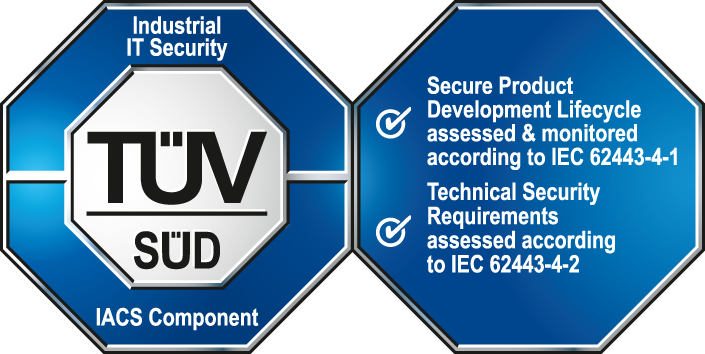HTTPS (SSL Connections)
To use HTTPS following steps must be followed:
- Create a new WinCC OA project on the server.
- Extract the required certificate from the server:
openssl s_client -connect localhost:443 - Import the received certificate to the main keystore:
bin\keytool -import -file <path to file> -keystore lib\security\cacerts -alias WinCC OA -storepass xxxx - Connect via browser.
The server must have a certificate file, which tells the client with whom it talks. The certificate file must reside in a config directory and must have the name "certificate.pem". The format of the file is PEM.
Create a Certificate with a Certificate Authority
The first step is to choose an provider that will create the certificate (e.g. verisign.com). After entering the company-related data on the homepage, a CSR file (certificate signing request) and a private key are necessary.
- To generate the a new private key open the Shell of the operating system, change directory to the /config directory of the project:
cd <project_path>/config
and enter the following command:
openssl genrsa 2048
> privkey.pem
- The CSR file will be generated with the following command:
openssl req -new -key privkey.pem -out cert.csr –outform <format required by
the provider>
Now you have to enter the following data:
- Country (2 letter code, e.g. AT)
- State/County/Region (e.g. Burgenland)
- City/Locality (e.g. Eisenstadt)
- Organization/Company (e.g. © ETM professional control GmbH )
- Organizational Unit (optional, e.g. a particular department of the company)
- Common Name: [host+domain name] (e.g. www.etm.at)
- Email adress (leave empty)
- Password (leave empty)
- Optional company name (leave empty)
- The generated CSR file must be transferred to the provider which creates the certificate and send it back. Now you have to import the received certificate into the /config directory of the project and a HTTPS connection to the server is possible. A cipher suite is used for the encryption.
Create a self-signed Certificate
Here a certificate is created manually. You can also use a panel - see chapter - Create SSL Certificates via Panel. Create the certificate type "Certificate for the HTTP Server".- In this example a private key (privkey.pem) is created.
- Change directory to the /config directory of the project:
cd <project_path>/configCreate the root key
-
openssl genrsa -aes256 -out private/ca.key.pem 4096 - Enter pass phrase for ca.key.pem:
secretpasswordVerifying -Enter pass phrase for ca.key.pem:
secretpassword
Create the root certificate
- Use the root key (ca.key.pem) to create a root certificate (ca.cert.pem). The
root certificate must contain a long expiry date, e.g. 30 years. If the root
certificate expires, the certificates signed by the CA become invalid.
openssl req -config openssl.cnf -key private/ca.key.pem -new -x509 -days 10950 -sha256 -extensions v3_ca -out certs/ca.cert.pem
Verify the root certificate
openssl x509 -noout -text -in certs/ca.cert.pem
Generate a Private Key
- To generate a new private key, enter the following command:
openssl genrsa 2048 > privkey.pem - This file will be stored in the /config directory of the project. Enter
the following openSSL command to create a new self-signed certificate:
openssl req -new -x509 -key privkey.pem -out certificate.pem -days 10951095 days are 3 years (defines the validity period for the certificate).
Note:The private key has to be RSA encrypted and base64 encoded in order to avoid certificate warnings.
- After this, an interactive process is started, where the user must enter some information and confirm them using the Enter key. The "Common Name" is important for the HTTPS server - enter the IP address of the server. Otherwise the web browser will not be able to allocate the certificate to the server. For example:
========================== You are about to be asked to enter information that
will be incorporated into your certificate request. What you are about to enter is
what is called a Distinguished Name or a DN. There are quite a few fields but you
can leave some blank. For some fields there will be a default value. If you enter
'.', the field will be left blank.
Country Name (2 letter code) [AU]:AT State or Province Name (full name)
[Some-State]:Burgenland Locality Name (eg, city) []:Eisenstadt Organization Name
(eg, company) [Internet Widgits Pty Ltd]:ETM Organizational Unit Name (eg, section)
[]:. Common Name (eg, YOUR name) []:192.168.129.1 Email Address []:.
==========================
Subsequently, the certificate.pem file is created and stored in the directory entered earlier.



